Taiwan’s extraordinary natural diversity extends to its soils.
The US Department of Agriculture divides soils into 12 orders, and Taiwan is the only place in the world where a researcher can collect samples of 11 of these in a single day, says Young Chiu-chung (楊秋忠), an academician in Academia Sinica’s Division of Life Sciences. The only soil order not present is gelisols (soils that contain permafrost).
Soil isn’t just the substrate in which much of our food is grown. Because it stores a great deal of carbon, it’s also a key variable in climate change.

Photo: Steven Crook
Asked if the health of Taiwan’s soils is declining, Young says, “Some soils in Taiwan are in greater danger now than 30 years ago, because, in some places, irrigation water isn’t separated from domestic and industrial discharges.”
If there are houses or factories next to farmland, he says, wastewater may enter those fields, and the soil may gradually accumulate toxins or heavy metals like lead and cadmium, the latter of which increases the risk of developing various organ diseases, including chronic kidney, heart and lung diseases, as well as nervous tissue disorders, according to recent studies.
The gradual loss of arable land due to urban sprawl is another negative, he says.

Photo: Steven Crook
On the other hand, government afforestation efforts have benefited water resources, and there’s a very strong two-way link between water quality and soil health.
Young urges people who have a garden or some farmland to apply organic fertilizers to the land.
“This will increase the soil’s organic-matter content and improve its fertility and productivity,” says Young, who spent most of his career teaching at National Chung Hsing University (NCHU). He is the founder of Tetanti AgriBiotech, a company which supplies enzyme products and machinery that can rapidly convert organic waste into organic fertilizer.

Photo: Chang Chung-yi, Taipei Times
Property owners shouldn’t apply pesticides to their land, nor use it as a dumping ground.
“Pesticides and waste can contaminate soil. Pesticides may kill non-target organisms, damaging soil biomass and microorganisms such as bacteria, fungi and earthworms,” he says, adding that microbial biomass plays an important role in the cycling of nutrients (carbon, nitrogen and phosphorus being the main ones).
HEAVY METALS
The threat posed by heavy metals — which can reduce crop yields and contaminate the food chain — is especially severe in Taiwan. The country not only has an exceptional number of factories for its land area, but also a form of agriculture that exacerbates the problem.
A study of cadmium contamination affecting Taiwanese rice published earlier this year in Environmental Science and Pollution Research points out that, compared with other crops, rice is more able to absorb toxins from soil and water.
“Paddy plants are grown under flooded conditions, which enable toxic elements to be absorbed by the roots of the plants and accumulate. The anaerobic conditions in paddy soil increase the bioaccessibility of toxic elements for rice,” write the authors, who are affiliated with National Taiwan University (NTU) and National Taiwan Ocean University.
Alarmingly, they note that the accumulation of non-biodegradable toxic elements means “their presence in marketed rice is essentially unavoidable” — and that the permissible level of cadmium in rice in Taiwan, at 0.4mg per kg, is double that in China. (Taiwan’s limit matches that set by the Codex Alimentarius Commission, the UN’s food safety body; the standard in Japan was lowered from 1.0mg per kg of unpolished rice to 0.4 in 2011.)
Chen Zueng-sang (陳尊賢), associate dean of the Taiwan Research Institute on Water Resources and Agriculture and formerly a professor in the Department of Agricultural Chemistry at NTU, is one of Taiwan’s leading experts on the removal of pollutants from soil, a process known as remediation.
A 2011 conference paper Chen co-authored for the East and Southeast Asia Federation of Soil Science Societies describes three soil remediation techniques.
Turnover and dilution — mixing surface soil with subsoil to reduce the concentration of heavy metals in the former — is cheap and fast. Moreover, compared to other remediation techniques, it has a minimal impact on crop production.
Chemical treatments aim to stabilize heavy metals in a form where they’re less likely to enter food crops via their roots. Experiments in contaminated fields indicate that adding calcium carbonate, manganese oxide and zeolite considerably reduces the extractability of cadmium and lead in soils, and cuts the uptake of those heavy metals by wheat shoots.
The third approach is phytoremediation, the use of particular plant species and associated microorganisms to clean up contaminated soil. This sounds like an ecologically-sensitive approach, but it’s not that simple. It’s been found that applying what are called chelating agents to the soil leads to greater concentrations of various heavy metals in the shoots of certain plants. However, using such agents — which boost the solubility and leaching of heavy metals — also increases the risk of groundwater contamination.
Chen has joined several experiments which aimed to identify what plants are best for soil decontamination.
One, reported in the International Journal of Phytoremediation in 2010, started by planting 33 different species on a polluted site in central Taiwan. After 31 days, Garden canna and Garden verbena had found to be especially effective at accumulating chromium; Chinese ixora and Kalanchoe for copper; rainbow pink for nickel; French marigold for zinc; and sunflowers for both nickel and zinc.
Phytoremediation isn’t a rapid process. Getting heavy metal contamination down to an acceptable level may take several planting-to-harvest cycles.
DEALING WITH CONTAMINATED SOIL
The Environmental Protection Administration’s (EPA) 2019 Annual Report on Soil and Groundwater Pollution Remediation mentions other responses to soil contamination, such as removing it for processing off-site, or using it to cover landfill sites. Since mid-2019, subsidies have been available so landowners can set up ground-based solar-power systems on polluted plots.
According to the report, at the end of 2019, the EPA was aware of 7,360 contaminated farmland sites covering a total of 1,178 hectares, slightly more than the previous year. Taiwan has just over 790,000 hectares of agricultural land.
Some 53 percent of the total contaminated land area is in Changhua County. Another 30 percent is in Taoyuan, while 8 percent is in Taichung
Every year since 2012, the EPA’s Soil and Groundwater Pollution Remediation Fund Management Board has spent more than NT$1 billion on cleanup efforts.
The EPA began analyzing soil contamination in 1983. However — as noted by a paper authored by a team from National Taiwan Ocean University and published late last year in Sustainability — few studies have “discussed the direct and cumulative effects of channel water quality and sediment [heavy metal] concentrations on [heavy metal] in paddy soil.”
The scientists tested water-channel sediments and irrigation water for heavy metals, and compared the results with what they found in nearby fields. Even allowing for atmospheric deposition of pollutants and the presence of heavy metals in fertilizers, they concluded that pollution came mainly from water and sediment in irrigation ditches.
Citizens who eat rice daily should pay particular attention to the paper’s assertion that most of the contaminated sediments in irrigation channels have yet to be properly treated, and that the EPA’s longstanding strategy “only focuses on monitoring the quality of discharge and irrigation water.”
The scientists argue that better management of irrigation systems, especially of sediments contaminated with heavy metals, should take priority over remediation of fields. Even though the discharge of wastewater from the country’s industrial sites is more tightly regulated than it used to be, there’s a risk that farmland will be recontaminated.
Steven Crook, the author or co-author of four books about Taiwan, has been following environmental issues since he arrived in the country in 1991. He drives a hybrid and carries his own chopsticks.
This column does not necessarily reflect the opinion of the Taipei Times.

We lay transfixed under our blankets as the silhouettes of manta rays temporarily eclipsed the moon above us, and flickers of shadow at our feet revealed smaller fish darting in and out of the shelter of the sunken ship. Unwilling to close our eyes against this magnificent spectacle, we continued to watch, oohing and aahing, until the darkness and the exhaustion of the day’s events finally caught up with us and we fell into a deep slumber. Falling asleep under 1.5 million gallons of seawater in relative comfort was undoubtedly the highlight of the weekend, but the rest of the tour

Youngdoung Tenzin is living history of modern Tibet. The Chinese government on Dec. 22 last year sanctioned him along with 19 other Canadians who were associated with the Canada Tibet Committee and the Uighur Rights Advocacy Project. A former political chair of the Canadian Tibetan Association of Ontario and community outreach manager for the Canada Tibet Committee, he is now a lecturer and researcher in Environmental Chemistry at the University of Toronto. “I was born into a nomadic Tibetan family in Tibet,” he says. “I came to India in 1999, when I was 11. I even met [His Holiness] the 14th the Dalai

Following the rollercoaster ride of 2025, next year is already shaping up to be dramatic. The ongoing constitutional crises and the nine-in-one local elections are already dominating the landscape. The constitutional crises are the ones to lose sleep over. Though much business is still being conducted, crucial items such as next year’s budget, civil servant pensions and the proposed eight-year NT$1.25 trillion (approx US$40 billion) special defense budget are still being contested. There are, however, two glimmers of hope. One is that the legally contested move by five of the eight grand justices on the Constitutional Court’s ad hoc move

Stepping off the busy through-road at Yongan Market Station, lights flashing, horns honking, I turn down a small side street and into the warm embrace of my favorite hole-in-the-wall gem, the Hoi An Banh Mi shop (越南會安麵包), red flags and yellow lanterns waving outside. “Little sister, we were wondering where you’ve been, we haven’t seen you in ages!” the owners call out with a smile. It’s been seven days. The restaurant is run by Huang Jin-chuan (黃錦泉), who is married to a local, and her little sister Eva, who helps out on weekends, having also moved to New Taipei